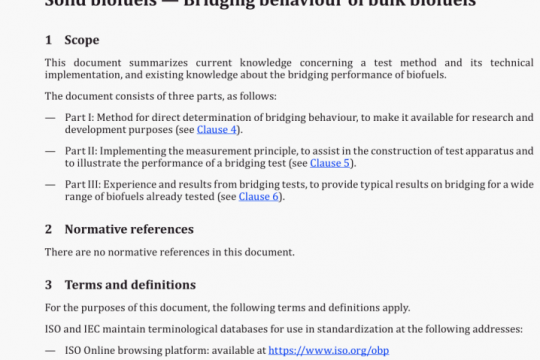BS ISO 4225 pdf free download
BS ISO 4225-2020 pdf free download.Air quality一General aspects – Vocabulary.
This document specifies terms and definitions that are related to air quality (see 3.1.1.1). These are either general terms or are used in connection with the sampling (see 3.3.3.1) and measurement of gases, vapours (see 3,1.5.8) and airborne particles (see 3.2.2,1) for the determination of air quality.
The terms included are those that have been identified as being fundamental because their definition is necessary to avoid ambiguity and ensure consistency of use.
An alphabetical index of the terms is provided in Annex A.
This document is applicable to all International Standards, ISO Technical Reports, ISO Technical
Specifications, and ISO Guides related to air quality.
2 Normative references
There are no normative references in this document.
3 Terms and definitions
For the purposes of this document, the following terms and definitions apply.
ISO and IEC maintain terminological databases for use in standardization at the following addresses:
— ISO Online browsing platform: available at http://www.iso.org/obp
— IEC Electropedia: available at http://www.clectropedia.org/
3.1 General terms
3.1.1 Terms describing air quality
3.1.1.1 air quality
features of the air which have an impact on humans (e.g., safety and health) and/or the environment
Note 1 to entry: Air quality is typically expressed in terms of the presence or absence of air pollution (3.2.1.2) (e.g. emissions (3.2.1.4) or conversions resulting from emissions, e.g., ozone), using one or more measurements.
Note 2 to entry: The concept of air quality can be used in reference to ambient air (3.1.1.3), indoor air (3.1.1.5), or workplace air (3.1.17).
3.1.1.2 air quality standard
specified attribute of the air intended to prevent or minimize impacts on humans (e.g. safety and health) and/or the environment
Note 1 to entry: Air quality standards are frequently defined statistically by setting a limit to the concentration of an air pollutant (3.2.1.1) over a specified averaging time (3.1.1.9).
Note 2 to entry: Air quality standards can have legal or advisory status in one or more jurisdictions.
3.1.3.4 nanoparticle
material with all three dimensions in the size range from approximately 1 nm to 100 nm
3.1.3.5 nanostructured particle
particle with structural features smaller than 100 nm, which can influence its physical, chemical and/or biological properties
Note 1 to entry: A nanostructured particle can have a maximum dimension substantially larger than 100 nm. EXAMPLE A 500 nm diameter agglomerate (3.1.3.6) of nanoparticles (3.1.3.4) would be considered a nanostructured particle.
3.1.3.6 agglomerate
<aerosols> group of particles held together by relatively weak forces, including van der Waals forces, electrostatic forces and surface tension
3.1.4 Terms related to exposure
3.1.4.1 breathing zone
space around the nose and mouth from which air is inhaled
Note 1 to entry: Technically, the breathing zone corresponds to a hemisphere (generally accepted to be 30 cm in radius) extending in front of the human face, centred on the midpoint of a line joining the ears. The base of the hemisphere is a plane through this line, the top of the head and the larynx. This technical description is not applicable when measuring air within respiratory protective equipment.
3.1.4.2 inhalation exposure
situation in which a chemical agent (3.1.2.2) or biological agent (3.1.2.1) is present in the air that is inhaled by a person
3.1.4.3 dermal exposure
contact between a chemical agent (3.1.2.2) or biological agent (3.1.2.1) and human skin
3.1.5 Other terms
3.1.5.1 cyclone
<meteorology> large circulatory wind system around a region ol low atmospheric pressure
3.1.5.2 stability
<atmosphere> state of hydrostatic equilibrium of the atmosphere in which a parcel of air moved from its initial level undergoes a hydrostatic force which tends to restore it to this level
3.1.5.3 chimney effect
phenomenon consisting of upwards movement of a localized mass of air or other gases caused by temperature differences
3.1.5.4 effective chimney height
height used for the purposes of calculating the dispersion of emitted gases from a chimney, and which differs from the real chimney height by an amount which depends on such factors as the exit velocity, buoyancy effects and wind speed as well as topography.BS ISO 4225 pdf download.




